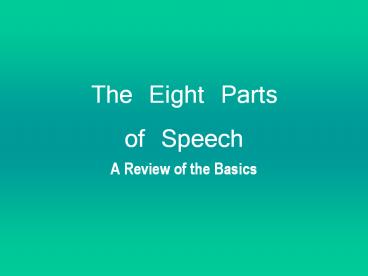The Eight Parts of Speech - PowerPoint PPT Presentation
1 / 10
Title:
The Eight Parts of Speech
Description:
Nouns are either COMMON or PROPER. A Common Noun is any person, ... Interjections. INTERJECTIONS are words that are used to show emotion, surprise, or excitement ... – PowerPoint PPT presentation
Number of Views:617
Avg rating:3.0/5.0
Title: The Eight Parts of Speech
1
The Eight Parts of Speech
- A Review of the Basics
2
Nouns
- A NOUN is a person, place, thing, or idea.
- Examples Ms. Grooms, brother, Irmo, Portable 2,
desk, books, freedom, education, anger - Nouns are either COMMON or PROPER
- A Common Noun is any person, place, thing or idea
- A Proper Noun is a specific person, place, thing,
or idea - COMMON NOUNS are either ABSTRACT or CONCRETE
- Abstract Noun You cannot touch it
- Concrete Noun You can touch it
3
Nouns
- COLLECTIVE NOUNS name a group.
- Examples team, band, class, flock, family
- COMPOUND NOUNS a compound noun is made of two or
more words - Examples music box, mailbox, sergeant-at-arms
- A POSSESSIVE NOUN shows ownership
- That is the dogs bowl.
- This is Ms. Groomss classroom.
- The students books are on the shelf.
4
Verbs
- VERBS are words that show action or existence.
- Verbs can be MENTAL or PHYSICAL
- Mental Verbs are actions performed in the mind,
like thinking, remembering, guessing, hoping,
loving, etc. - Physical Verbs are actions performed by the body,
like running, eating, skipping, slapping
5
Pronouns
- PRONOUNS take the place of a noun or pronoun in
the sentence to keep our language from being too
repetitive. The nouns or pronouns they replace
are their ANTECEDENTS. - Michael gave Ms. Grooms Michaels homework.
Michael asked Ms. Grooms a question then went to
Michaels seat. - Michael gave Ms. Grooms his homework. He asked
her a question then went to his desk. (Michael is
the antecedent of his, he, etc. and Ms.
Grooms is the antecedent of her.)
6
Adjectives
- ADJECTIVES are words that describe other words.
They might tell what color something is, how big
it is, how old it is, how pretty or ugly it is,
etc. Adjectives make our sentences more
interesting. - The lady walked down the street clutching her bag
against her. - The old lady walked down the dark street
clutching her brown bag against her.
7
AdVerbs
- ADVERBS are words that describe a verb or another
adverb. They gives us information about how long
something happened, how quickly something
happened, why something happened, and to what
extent something happened. - The girl studied very intensely.
- Screaming wildly, the crowd stood on its feet.
8
Prepositions
- PREPOSITIONS are words that connect nouns and
pronouns to other words in the sentence. A good
way to identify many of them is to think, this
is something that a bird could do to a cloud.
Prepositions are often direction words. - She moved toward the door.
- He ran behind the barn.
- Mark walked through the house.
- The boy jumped over the box.
9
Conjunctions
- A CONJUNCTION is a word that connects more than
one word or idea together. The most common
conjunction is and. - Mark and Sam went by the school.
- I want steak or chicken for dinner.
- I wanted to go for a run, but it was raining.
10
Interjections
- INTERJECTIONS are words that are used to show
emotion, surprise, or excitement in a sentence.
They usually stand alone, and are punctuated with
an exclamation point (!) or separated off by a
comma (,). - Wow! What a catch!
- Ah, I see.
- Geez! That girl is crazy.
- Oh, that was a close one.































